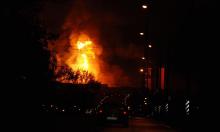Shortcut From West To East Runs Across Russia's North
 Siberia or the Far East can be reached from the western (European), part of Russia in three ways. An air flight from Moscow to Vladivostok with refueling in Irkutsk and Khabarovsk will take one 16 hours. If you fly to a nomad camp in Yakutia, you will have also to take a helicopter, then ride in a car, in a cross-country vehicle or in a reindeer-driven sleigh. Finally, there is another way. You take a trian with a decent restaurant, travel a week in an upholstered carriage and watch spectacular scenery from a window, if you want to see for yourself what Russia as an immense bridge between Europe and Asia really is.
Siberia or the Far East can be reached from the western (European), part of Russia in three ways. An air flight from Moscow to Vladivostok with refueling in Irkutsk and Khabarovsk will take one 16 hours. If you fly to a nomad camp in Yakutia, you will have also to take a helicopter, then ride in a car, in a cross-country vehicle or in a reindeer-driven sleigh. Finally, there is another way. You take a trian with a decent restaurant, travel a week in an upholstered carriage and watch spectacular scenery from a window, if you want to see for yourself what Russia as an immense bridge between Europe and Asia really is.
And the third way to the east is the longest and the sternest one, but it is shorter than the other two. The Northern Sea Route is a route along the arctic coastline of Russia and it stretches 14,280 kilometers from St. Petersburg to Vladivostok, or you go 3,023 miles from the Kara Strait to the Providence Bay along the main ice route. If you venture to go that way, then you will see six seas - the Barents Sea, the Kara Sea, the Laptev Sea, the East-Siberian Sea, the Sea of Chukotsk and the Bering Sea, sail along the great Siberian rivers Ob, Yenisei and Lena and visit the main Russian ports in Arctic Zone - Igarka, Dudinka, Tiksi and Pevek. Navigation is open there from two to four months in a year, when the shores of the Arctic Ocean are capped with ice and a polar night is gives way to a polar day, which lasts half a year. Five Russian nuclear-driven icebreakers and escort ships allow prolonging this period for a few more months. However, ice does not melt entirely in the Taimyr and Ayon areas even in the warmest summer days. Therefore beginning with late June Russian ships bring food, fuel, consumer goods, and construction materials to the coastal regions of the Arctic; and in October and November the Murmansk Shipping Lines sum up the northern supplies.
The Northern Sea Route was for the first time passed during a single navigation period, without wintering, by a polar expedition led by Otto Schmidt on board the icebreaker Sibiryakov. It happened in 1932, and after that ports were built all through the 1930s and navigation was developed at a high pace - the Soviet Union was intensively developing the Russian North, which accounts for as much as one-third of Russia's territory.
At the ports situated at the estuaries the Sberian rivers cargo is shipped deep into Siberia. There should be no delay, as permafrost in Russia's North leaves littl3e opportunity for agriculture - navigation stoppage may leave people without food.
Foreigners visiting those parts say Russians hide their North from the rest of the world. It hard to argue with them - there is no international navigation along the Northern Sea Route, though international interest in this transport artery is shown now and again and is supported in Russia. This occurred, for instance, in the 1960s and 1970s, when the Soviet Union launched a policy of detente, and later, in the late 1980s, after the last USSR President, Mikhail Gorbachev, speaking in Murmansk, the famous Russian ice-free port, called for international cooperation in the Arctic Zone. However, there also was an episode when during World War II that sea route was used for lend-lease supplies to the USSR from the U.S. and Canada.
The present interest in this route on the part of Europeans, or Japanese will be understandable if you take a look at the map. To reach Yokohama from Hamburg through the Arctic region one is to cover a distance of 6,600 sea miles, which is almost half of the traditional journey through the Suez Canal and the warm seas, which is 11,400 sea miles lone.
There is another reason why in twenty or thirty years the Arctic area would be plied by ships flying various flags of the world. The abundant of gas and oil resources doom this stern area to constant presence of people.
Energy Minister Igor Yusufov assures that up to one-third of oil and gas resources are located there. Thus, the resources of the Shtockman gas field alone contain 3.2 trillion cubic meters of gas. According to the Energy Ministry, within the period before 2015-2020 the amount of liquefied gas transported from Yamal may total 1 to 3 million tons, 1 to 3 million tons of gas condensate may be extracted from the area of the Ob and Yenisei rivers and 25 to 30 million tons of oil may be pumped from oilfield in the Timano-Pechora basin.
Transport Minister Sergei Frank assessed potential of transit by the Northern Sea Route at 8 to 12 million tons a year. The same amount of cargo is planned to be carried along this route by 2008-2020. Precisely this amount is needed for the Northern Sea Route to become self-supporting in financial terms (at present goods deliveries along it are subsidized by the government.) Will international navigation begin in the Arctic? It may be very advantageous, but also may be rather dangerous. Arctic ice does not forgive carelessness, which means that international cooperation in this case is indispensable.
Yury Filippov, RIAN
Subscribe to Pravda.Ru Telegram channel, Facebook, RSS!





